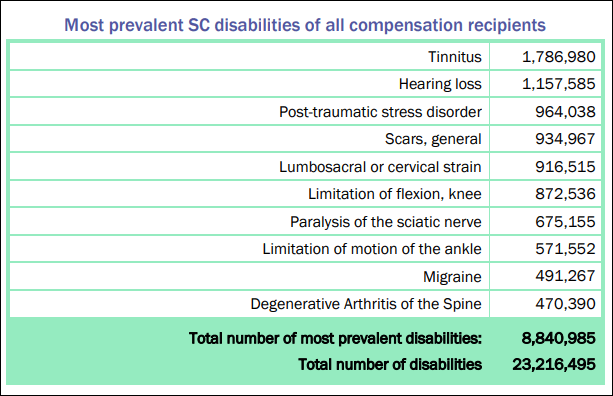When we reflect of the toll that our military pays in service of their country, we often think of the physical and mental trauma that can happen on the battlefield. And while conditions like post-traumatic stress disorder (PTSD) and physical wounds are certainly widespread, auditory injuries such as tinnitus and hearing loss consistently top the list of most prevalent service connected disabilities for veterans.
Service connected disabilities (SC) are determined by the U.S. Department of Veterans Affairs (VA) to be an injury or illness that was incurred or aggravated during active military service. For well over the last decade, auditory injuries like tinnitus and hearing loss have consistently been listed as the most prevalent service connected disabilities.
The Veterans Benefits Administration regularly publishes its annual report to provide a data-driven analysis of the cost of the benefits program, and what those funds are being utilized for. Looking at the 2017 list of most prevalent SC disabilities of all compensation recipients shows that tinnitus and hearing loss are the most widespread disabilities.
This is far from a recent development, as reports over the last 10+ years show similar statistics.
How Serious are Tinnitus and Hearing Loss?
Even though tinnitus and hearing loss aren’t life-threatening conditions, they can severely impact a person’s quality of life.
Tinnitus is often described as a ringing or buzzing in one or both ears and is usually a symptom of an underlying injury to the outer, middle, or inner ear. Prolonged exposure to loud noise is one of the most common risk factors for tinnitus. Loud noises can damage the tiny sensory hair cells in the ear that are responsible for transmitting sound to the brain. When these hair cells are damaged, they can transmit signals to the brain randomly, leaking electrical impulses that are interpreted as sound.
People who suffer from tinnitus often report additional complications like pain, trouble sleeping or concentrating, issues with memory, and depression and anxiety in some cases.
Why is the Rate of Tinnitus and Hearing Loss in the Military so High?
On the surface, this seems like an obvious question. Soldiers are regularly exposed to high volume environments, ranging from the din of gunfire to powerful equipment like jet and helicopter engines. But the high rate of hearing loss and tinnitus disabilities in the military may have been exacerbated by inadequate and defective protective equipment.
In July 2018, 3M agreed to pay $9.1 million to resolve whistleblower allegations that it knowingly sold defective combat earplugs to the U.S. military. Not only was 3M accused of failing to disclose defects that hampered the effectiveness of the earplugs, but the lawsuit also alleged that Aearo (the original manufacturer of the earplugs, which 3M acquired in 2008) deliberately falsified the company’s internal noise reduction rating test results and continued selling the earplugs to the military.
The Combat Arms Earplugs, Version 2 (CAEv2) were dual-ended earplugs. One end was intended to block out all noise, while the other end was supposed to protect the user from loud blasts while allowing other sounds, such as commands and conversations, to be heard.
The lawsuit alleged that the CAEv2 earplugs contained a design defect that would cause the earplugs to loosen imperceptibly during use, effectively making the earplugs useless. Because of this defect, thousands of soldiers may have been exposed to dangerously unsafe levels of noise while believing they were protected.

0 Comments